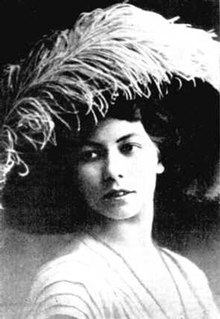Nijinska
| Bronislava Nijinska | |
|---|---|
 |
|
| Native name | Бронисла́ва Фоми́нична Нижи́нская |
| Born |
Bronislava Fominichna Nizhinskaya January 8, 1891 Minsk, Russian Empire |
| Died | February 21, 1972 (aged 81) Pacific Palisades, California |
| Occupation | ballet dancer, choreographer, ballet teacher |
| Spouse(s) | Alexandre Kochetovsky Nicholas Singaevsky |
| Children | Leo Kochetovsky, Irina Nijinska |
| Relatives | Vaslav Nijinsky (brother) |
| Awards | National Museum of Dance's Mr. & Mrs. Cornelius Vanderbilt Whitney Hall of Fame, 1994 |
Bronislava Nijinska (Polish: Bronisława Niżyńska; Russian: Бронисла́ва Фоми́нична Нижи́нская, Bronislava Fominichna Nizhinskaya, Belarusian: Браніслава Ніжынская); (January 8, 1891 [O.S. December 27, 1890] — February 21, 1972) was a Polish ballet dancer, an innovative choreographer, and a teacher. She came from a family of professional dancers. Her career started in Russia, moved to France, then continued in Europe and the Americas.
Nijinska played a pioneering role in the movement that diverged from 19th-century classical ballet. The introduction of modern form and motion, and a minimalist narrative, set the stage for neoclassical works to come.
After formal ballet training in Sankt Peterburg the Russian capital, she became an 'Artist of the Imperial Theatres' in 1908. An early breakthrough came in 1910 when she was a member of Diaghilev's Ballets Russes. For her solo Nijinska created the role of Papillon in Carnaval, a ballet designed by Fokine.
She assisted her brother Vaslav Nijinsky as he created the memorable choreography for L’Apès-midi d’un faune, which Ballets Russes premiered in 1912. In Petrograd and Kiev during the great war then the revolution, she performed in theaters, created her first choreographies, started a ballet school, and wrote a book on the art of movement.
In 1921 she rejoined the Ballet Busses in Paris. Diaghilev appointed her choreographer of this influential company. Nijinska thrived, choreographing several cutting-edge ballets to contemporary music, e.g., by Stravinsky. In 1923 she created her most iconic work Les Noces [The Wedding].
...
Wikipedia
